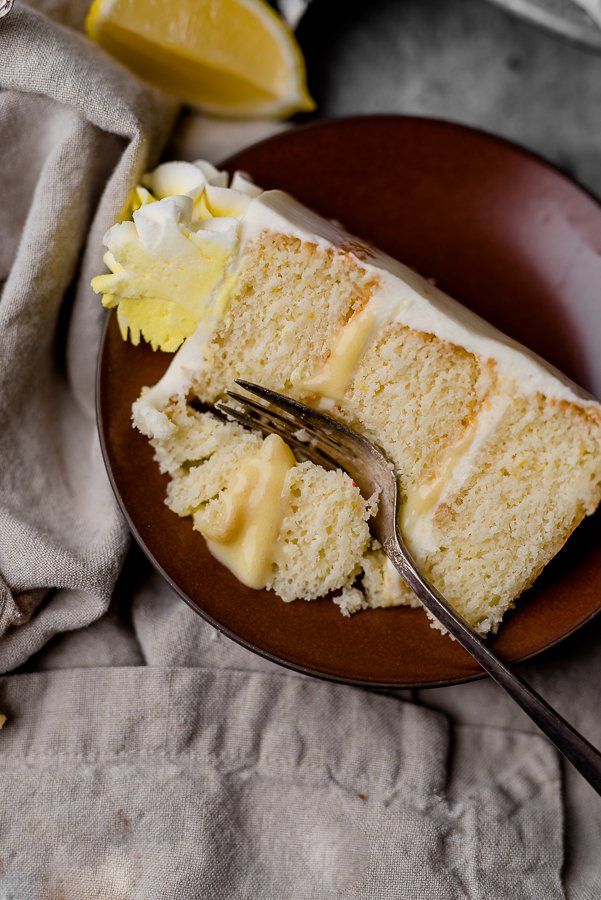Fresh Lemon Cake with Cream Cheese Icing
With both fresh squeezed lemon juice and lemon zest, this cake has the perfect zing of citrus flavor, all surrounded by the softest of cake crumbs.
Before I took to food photography and blogging, I ran a home baking business, and while I still take orders occasionally, I have almost entirely switched to this platform—I enjoy it so much more. This lemon cake was my most ordered cake, and although I have held it close to my heart, I’ve decided to slowly release my most popular desserts, starting with this citrus treat.
What Makes This Cake Special?
It is the combination of flavors and textures, that make this cake entirely delightful to eat. It has a nice citrus kick from fresh lemon juice and zest—no extracts here—and has a beautiful crumb, from my trusted technique of using a combination of cake flour and all-purpose flour. The mix of a lower protein flour, alternated with full fat buttermilk, yields an incredibly tender crumb.
Further, this cake is versatile, and can be made using a variety of fillings and flavors. Here, I am sharing it with a lemon curd filling and cream cheese icing, but raspberry, blackberry—any fruit really—would pair nicely with this cake.
What Is Citrus Season?
It’s a wonderful time of year because although it’s winter, a certain variety of lemon brings a bright spot of joy to bakers all around. This varietal is called a Meyer Lemon— it’s a cross between a lemon and a mandarin orange. Meyer Lemons are a bit sweeter than your traditional lemon, and I have also found them to be juicer, which is a positive when a recipe calls for fresh squeezed juice. The rind is thinner, and has more depth of flavor than a regular lemon peel—it adds its own unique flavor kick to recipes, and some individuals will only use Meyer lemons for certain dishes.
For this dessert, any lemon will suffice, but when Meyer Lemons are available, especially at a good price, they’re my first choice. Within the recipe, I provide a range of lemon juice needed for the cake. I did this for the sole reason that not all lemons are created equal, and further, everyone has a different threshold for citrus flavor. I personally like a full citrus kick, but occasionally I encounter a lemon that is particularly sour, and less juice is needed for full flavor.
Checking For Cake Doneness
At the bakery I worked a previously—a very popular and successful bakery in my area—we didn’t use timers or toothpicks in the traditional sense to check for cake doneness. Instead, we had large ovens, full of different cakes, cookies, brownies—you name it—and we checked for doneness with our hands. There was a timer used, but only to make sure we remembered to check the oven for the baked good that was closest to being finished. Let me tell you, this was super intimidating when I first started, and I definitely don’t expect this technique to be adopted in your home kitchen, but it’s something to think about. It felt empowering to understand when a bake was ready, using my senses, rather than blindly trusting a timer or tool.
With cake, one or two minutes too long, and the cake is overdone. One or two minutes pulled too early, and the cake is gooey inside. Ovens don’t always bake at the temperature indicated, and sometimes have a 10-15 degree (or more!) discrepancy—this can obviously have a negative impact on finished bake.
This is what challenges bakers, and what makes it so satisfying when a bake turns out perfectly. Using a toothpick is an effective tool, and don’t get me wrong, for certain recipes—like brownies—I always use a toothpick, but consider this a challenge to tune into your other senses. At home, I have melded both the techniques I learned at the bakery, with what is practical in my home kitchen. I use a timer as a base line, but after that threshold is reached, I look with my eyes and hands, using my senses as an indication when the cake is done. Tell tale signs include: a cake that starts to pull away from the sides of the pan, a cake that feels bouncy when touched, and further, If you pull a tiny bit of the cake from the middle, and it’s cooked—the cake is done.
Final Tip
Making a lemon curd filling is entirely optional, but does add a delicious element to the cake. Because of the lemon curd, I opted to keep the cream cheese icing plain. Lemon juice can certainly be added to the cream cheese icing, for further citrus flavor, but keep in mind this could make the frosting looser when decorting the cake.
Fresh Lemon Cake

Ingredients
- 1 stick salted butter, room temperature
- 1 1/2 cups granulated sugar
- 2 tablespoons canola oil
- 3 large eggs, room temperature
- 1 cup all-purpose flour
- 1 cup cake flour
- 1 teaspoon baking powder
- 1/2 teaspoon baking soda
- 1/4 teaspoon salt
- 1 cup full fat buttermilk
- 1-2 tablespoons lemon zest, to taste
- 2-4 tablespoons fresh squeezed lemon juice, to taste
- 1 large egg
- 4 large egg yolks
- 1/2 cup granulated sugar
- 1/3 cup fresh lemon juice
- Zest of 1 small lemon
- 3 tablespoons butter, room temperature
- 1 stick salted butter, room temperature
- 8 ounce block cream cheese, room temperature
- 1/4 teaspoon vanilla
- 3-4 cups powdered sugar, to taste
- Pinch of lemon zest
Instructions
- Preheat oven 350 degrees F. Generously butter and flour three 6" cake pans. To guarantee the cake won't stick, line the bottom of the greased cake pans with parchment paper rounds. Set aside.
- In a mixer, fitted with the paddle attachment, cream the butter and sugar on medium speed for 4 minutes. Drizzle the oil into the bowl on medium-low speed. Once incorporated, turn the mixer back to medium speed for another 2 minutes.
- Add eggs one at a time, briefly mixing batter on medium speed until smooth, scraping the bowl after each egg addition.
- In a separate bowl, using a fine mesh sieve, sift the flours, baking powder, baking soda and salt. Spoon and level the flours for an accurate measurement.
- Add 1 cup buttermilk into a glass measuring cup. Alternating between the dry ingredients and the buttermilk, add 1/3 of flour into the mixing bowl on low speed. Immediately follow with 1/2 of the buttermilk, followed by another 1/3 of the flour and the second 1/2 of the buttermilk. Finish with the remaining flour mixture. The mixer should be kept on low speed, so the flour and liquid don't splash out of the bowl. Add lemon juice and zest into the batter and mix until just incorporated. Scrape the bowl, making sure any dry ingredients trapped at the bottom are brought to the top and briefly mix one more time.
- Pour batter evenly into the prepared pans. Start assessing your cakes at 25 minutes, but they could take up to 35 minutes or longer to bake, depending on your oven's temperature. When a toothpick inserted comes out clean, the cake is done. Cool pans for 10 minutes, before running a knife around the edge of the pan, and turning out the cake. Place cake on wire rack to finish cooling. Once cake is cooled, cover with saran wrap and refrigerate for at least 1 hour. This step is optional, but makes icing the cake easier.
- PLEASE NOTE: This recipe yields about 1 cup of curd, which is more than needed for the cake filling. The rest can be stored up to a week in the refrigerator, and used for other baking projects. Or alternatively, a dollop of lemon curd can be placed on each piece of cake when served.
- Using a double boiler, whisk together the whole egg, egg yolks, sugar, lemon juice and zest. Cook over medium-low to medium heat, stirring constantly, until the ingredients have thickened.
- Once thickened, remove from heat, and press through a fine mesh sieve into a bowl, leaving behind the remnants of lemon zest, and any egg that may have cooked. Immediately stir in the softened butter.
- Cover with a piece of plastic wrap, pressed directly on the surface of the curd to prevent a skin from forming. Place in the refrigerator to cool for 1 hour before filling the cake.
- With an electric mixer fitted with the paddle attachment, mix the cream cheese and butter on medium speed until there are no lumps, and the consistency is smooth. Add vanilla and mix briefly.
- Add sifted powdered sugar to the bowl, 1 cup at a time, mixing first on low speed to prevent splashing, then turning the mixer to medium-low until it's incorporated. Repeat process with remaining 2 cups of powdered sugar. Add the lemon zest into the bowl and briefly mix one more time to complete the icing.
- Place one layer of cake on a clean turn table or cake board with a small dollop of icing underneath. This works as a glue, helping prevent the cake layers from sliding around while icing. Place a dollop of icing on top of the first cake layer, and spread evenly with a small offset spatula or knife. Using a pastry bag, create a ring of cream cheese frosting around the edge of the first cake layer. Carefully place a few spoonfuls of chilled lemon curd into the center of the well, and gently spread to the edge of the cream cheese ring. The cream cheese ring acts as a guard to keep the lemon curd from oozing out of the cake. Place the second cake layer on top of icing and repeat process. Once the third and final layer has been set, place another dollop of icing onto the top of the cake, smoothing evenly, letting excess icing drop to the side of the cake.
- With the rest of the icing, using an offset spatula, put a even layer of icing around the entire cake, with a back and forth motion.
- Using a bench scraper (also known as cake smoother) with your dominant hand, hold it steady against the cake, but slightly angled toward the cake, to aid in smoothing, and slowly move the turn table with the other hand, while not moving the scraper, and keeping it as straight and steady as possible. As excess icing builds on the scraper, place it back into the mixing bowl, and continue smoothing the cake with a clean scraper. This cake is intended to be semi-naked, so as you scrape the excess icing off the cake, bits of the cake underneath will be exposed. See blog pictures for reference.
- While smoothing the sides, a lip of icing will form around the top of the cake. Using an offset spatula, gently sweep away the lip with a motion toward the center of the cake. Rotate the cake, and sweep until the lip has been removed, and top of the cake is smooth. Any leftover icing can be used to decorate the cake with a beaded boarder, or another decoration of choice. Store cake in the refrigerator until 2 hours before serving.
You May Like These…























